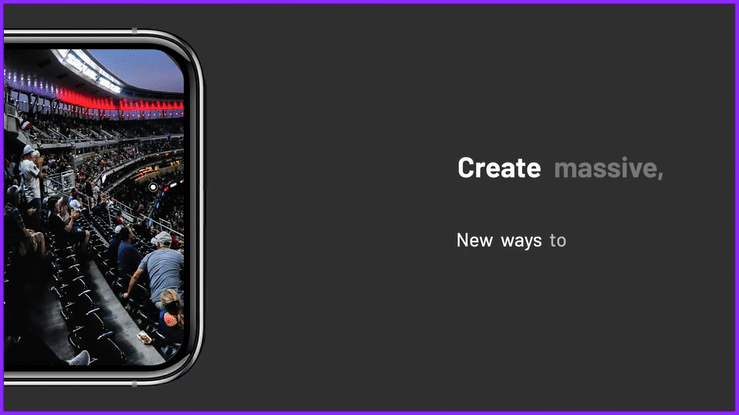Augmented Reality
Stadium View: AR Will Lead Sports Marketers Into the Metaverse
By Mark Penn, Chairman and CEO, Stagwell
and Josh Beatty, Founder and CEO, ARound
CONTACT
Mark Penn
mark.penn@stagwellglobal.com
FEATURING
Marketing Frontiers is a new series from Stagwell exploring the methods, mediums, and messes modern marketers will grapple with over the next decade as they chart transformation in the discipline. This January, Stagwell is exploring the new frontiers of Augmented Reality.
Event-based AR can help marketers attract audiences at scale for new forms of shared, blended, and branded experiences.
We tend to envision AR as a means of distraction but there is transformative power in combining the physical and the augmented for highly immersive, interactive experiences.
AR at live sporting events can help create persistent, relevant, and shared experiences that will engage casual fans while enhancing the experience for sports fanatics.
Augmented reality has transformed from a bespectacled fad to an emergent marketing frontier for modern brands in recent years. Still, there is still much work to be done to create AR audiences at scale, attracting the masses.
Why is it hard to scale AR? Because – to date – AR has focused on the individual. We believe that the transformational power of AR is in creating experiences that bring people together around a common place and purpose. Purely functional applications like seeing how a piece of furniture might fit into your home are useful but do little to attract the mass consumer audience AR needs to go mainstream.
What if instead we focus our AR experimentation on augmenting shared experiences like sporting events, in stadiums with captive audiences that are naturally some of the most enthusiastic consumer bases in the world? As sports leagues adapted to the pandemic, marketers learned consumers hunger for more dynamic engagement with their favorite teams and players. They want to get closer to the action, closer to the players, and bond with one another over experiences they’ll remember for a lifetime.
Let’s use AR to get there. We believe sports brands have a strong opportunity to power more immersive and meaningful experiences with the next frontier of augmented reality: event-based AR.
The promise of event-based AR is to bring content to context, providing for more immersive and meaningful experiences connected to the events and people around us. AR can fuel moments of catharsis for the consumer, creating powerful emotional connections to brands, stadiums, and other key fan and player locations.
We already know sports fandom is a lifelong affiliation. Augmented reality can help brands extend that fever into a new dimension, offering interaction, socialization and new forms of connection
ARound helps venues and retailers create augmented reality experiences for live events, bringing audiences together at scale where they can play, interact, and socialize in completely new and exciting ways.
‘Mario Party But With 30,000 People’
Sports marketers can use augmented reality to power stronger consumer experiences with fun, relevant, and shared brand moments.
The transformational power of AR is in creating experiences that bring people together around a common place and purpose.
Building Fun Moments
Every Thanksgiving, one relative is bound to recount an infamous fly-ball he caught from the seats at a baseball game growing up. And even the least sports-engaged Bostonian becomes a model hometown fan when the Patriots are due for more Super Bowl wizardry. Sports marketers know best that the memories fans make at sporting events are some of the most persistent experiences they’ll have in their lives.
So why not use AR to bring more of those experiences to a wider swath of fans?

Everyone might not be able to carry a flyball away with them as a lifelong souvenir, but every fan can experience moments that will turn into memories. With AR, fans in seats with lackluster angles can be brought into the action while players personalities can become larger than life, creating memorable moments that will dominate social media. Adding more experiential touchpoints via AR can make a standard Sunday game fodder for “remember when!” stories for years to come.
Serving Relevant Content
Using AR to add context to content can help brands further engage consumers on location, arming them with an agile new tool for building the compelling experiences that drive value. With event-based AR integrations, brands can adapt flexible content based on everything from proximity to the main stage to the affiliations of fans. Advertising in-game can be tailored, too, to reflect first-party inputs like a consumer’s favorite sports team, hometown, and more. Ultimately, the tech will serve as a powerful way to recapture and convert attention otherwise lost to consumers’ mobile browsing habits during live events.
Keeping fans engaged before, during, and after the game with personalized content enables a myriad of brand integrations. With just baseline first-party data input by users about team fandom, hometown, favorite players and preferences for merchandise, a whole universe of addressable AR content opens up, activated through their mobile devices.

Creating Shared Social Experiences
Let’s be honest: while fans may be physically captive, of a sort, at in-person sporting events, it’s another game to capture and keep their attention. At the same time, sports is inherently social – something that positions it well to beat the AR trap of failing to scale by being mired in individual experiences. Leveraging AR to extend shared moments through every part of the game will help build closer connections between teams, players, and their fans, bringing talent on the field to life in multi-sensory, bigger-than-life arenas.

Layering gamified content, player stats and optional replays in AR during games can keep fans focused on and interacting with the field. Brands might stoke team rivalries with interactive competitions during games, with fans’ actions contributing to an aggregate team score. At the end of a game, fans from the winning team might get virtual collectibles or NFTs that build up to larger prizes with more and more engagement at AR-enabled locations, ultimately winning season passes or exclusive IRL merchandise. During intermissions, fans could open their phones to participate in competitions like tug of war fueled by the in-app engagement of 30,000 people, with rival team mascots scaled as AR avatars on the field. You can even imagine beloved mascots like The Phillie Phanatic or Mr. Met swarming the field with AR-doubles for intermission shows that extend beyond the physical to engage fans throughout the entire stadium, not just close to the field.
While our focus is ostensibly on AR moments connected to physical locations and powered by mobile, it’s not hard to see how marketers can activate AR-integrated apps or hardware to plug at-home fans into live sports.
Related
Articles
In the News, Press Releases
Jul 14, 2025
JULY HARVARD CAPS / HARRIS POLL: OPINIONS ON “BIG BEAUTIFUL BILL” SPLIT WITH 44% OF VOTERS SUPPORTING IT, BUT MOST POLICIES HAVE MAJORITY SUPPORT WITH MANY POPULAR TAX CUTS

In the News, Press Releases
Jul 09, 2025
STAGWELL LAUNCHES STAGWELL MEDIA PLATFORM (SMP), A CENTRALIZED TEAM OF GLOBAL MEDIA, TECHNOLOGY AND DATA INVESTMENT EXPERTS

In the News, Investments & Financials, Press Releases
Jul 08, 2025
Stagwell (STGW) Schedules Webcast to Discuss Financial Results for the Three Months Ended June 30, 2025






